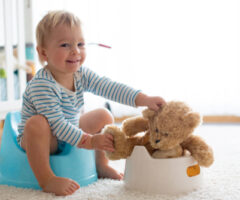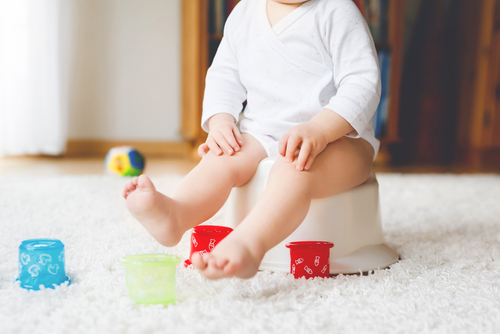 Potty training is an important milestone for every child, and it can often feel like a daunting task for parents. When it comes to potty training girls, there are a few tips and techniques that can help make the process smoother and more successful. In this blog post, we will provide you with some valuable tips on potty training specifically for girls.
Potty training is an important milestone for every child, and it can often feel like a daunting task for parents. When it comes to potty training girls, there are a few tips and techniques that can help make the process smoother and more successful. In this blog post, we will provide you with some valuable tips on potty training specifically for girls.
1. Introduce the Concept Early:
It is important to start introducing the concept of potty training to your daughter early on. Talk to her about using the potty, show her children’s books or videos about potty training, and let her watch you or other female family members use the toilet. This will familiarize her with the idea and make her more comfortable with the process when the time comes.
2. Choose the Right Potty Seat:
When selecting a potty seat, consider choosing one that is specifically designed for girls. These seats have a smaller opening and may feature a splash guard, which can help prevent accidents and make the process less messy. Additionally, let your daughter choose her own potty seat with her favorite color or character to make it feel more personalized and exciting.
3. Teach Good Hygiene Habits:
Apart from teaching your daughter how to use the potty, it’s crucial to instill good hygiene habits early on. Teach her to wipe front to back to prevent the spread of bacteria and avoid urinary tract infections. Encourage her to wash her hands thoroughly after using the potty, and make it a fun and rewarding ritual by using colorful soap or singing a favorite song while washing.
4. Use Positive Reinforcement:
Positive reinforcement can go a long way in encouraging your daughter during the potty training process. Praise and reward her whenever she successfully uses the potty or makes progress. This can be through verbal praise, stickers, small treats, or a reward chart where she can track her achievements. Celebrating her successes will boost her confidence and motivate her to continue with her potty training journey.
5. Encourage Frequent Bathroom Visits:
Girls tend to have smaller bladders than boys, so it’s important to encourage frequent bathroom visits to avoid accidents. Set a timer or reminder for every hour or two and take your daughter to the bathroom. Additionally, encourage her to go before leaving the house or before engaging in activities that may make it difficult to access a bathroom, such as long car rides or outings.
6. Teach Proper Sitting Position:
Girls have a different anatomy than boys, so teaching them the proper sitting position is essential. Show your daughter how to sit correctly on the potty, with her bottom and legs facing forward. Encourage her to relax and avoid straining, as this can lead to constipation or withholding stools. You can also use a step stool to provide stability and support for her feet.
7. Be Patient and Consistent:
Potty training takes time, and accidents are a part of the learning process. It’s essential to be patient and not get discouraged. If your daughter has an accident, stay calm, and avoid punishing or shaming her. Instead, gently remind her of the proper way to use the potty and encourage her to try again next time. Consistency is key, so stick to a routine and continue providing guidance and support throughout the potty training journey.
Conclusion:
Potty training girls can have its challenges, but with the right approach and techniques, it can also be a rewarding and successful experience. Remember to introduce the concept early, choose the right potty seat, teach good hygiene habits, use positive reinforcement, encourage frequent bathroom visits, teach proper sitting position, and most importantly, be patient and consistent. Every child is unique, so trust your daughter’s abilities and customize your approach to fit her needs. With time and patience, she will become a potty-trained girl, and you’ll be proud of her accomplishment.
Got Questions? Let Us Help!
Established in 2017, Kids Kingdom Early Learning Center is a child care and learning center located in Greenwood, Indiana. We specialize in providing a variety of services including daily nondenominational Christian education, before care and aftercare services, Paths to QUALITY™ Level 3 provider, On My Way Pre-K Provider, director-led weekly Bible learning time, military discounts, available through NACCRRA, Kindergarten readiness, CCDF provider, and more for children from newborn to 6 years old. As a family-owned and operated business, we value providing Christian education and quality services. Contact us for more information or come visit us today!
 Potty training is an important milestone in a child’s life, and it can often be a challenging process for both parents and children. When it comes to potty training boys, there are a few tips and strategies that can make the process a little easier. In this blog post, we will explore some potty training tips specifically tailored for boys.
Potty training is an important milestone in a child’s life, and it can often be a challenging process for both parents and children. When it comes to potty training boys, there are a few tips and strategies that can make the process a little easier. In this blog post, we will explore some potty training tips specifically tailored for boys.
1. Start when your child is ready
The first step in successful potty training is to make sure your child is ready. While some boys may show signs of readiness as early as 18 months, others may not be ready until they are closer to 2 or 3 years old. Look out for signs such as showing an interest in the bathroom, staying dry for longer periods, or imitating others’ bathroom habits. Starting potty training too early can lead to frustration and resistance, so it’s important to be patient and wait for your child to show signs of readiness.
2. Introduce the standing position
One of the main differences in potty training boys is the introduction of the standing position. For many boys, standing up to pee is a big part of transitioning to using the toilet. Start by teaching your child to sit on the potty, and once they are comfortable with that, introduce the standing position. Show them how to aim and encourage them to practice standing up. It may take some time before they fully grasp the concept, so be prepared for some accidents along the way.
3. Provide visual aids
Boys are often visual learners, so providing visual aids can be incredibly helpful during the potty training process. Consider placing stickers or targets in the toilet bowl to make aiming more engaging and fun for your child. You can also use picture charts to track their progress and reward them with small prizes or stickers for each successful use of the potty. Visual aids can help motivate and encourage your child to use the toilet independently.
4. Use positive reinforcement
Potty training can be a challenging and sometimes frustrating process, but it’s important to remain positive and supportive throughout. Praise your child for their efforts, even if they have accidents along the way. Instead of focusing on the accidents, emphasize the successful uses of the potty. Positive reinforcement, such as verbal praise or small rewards, can go a long way in motivating your child to continue their potty training journey.
5. Teach proper hygiene
Potty training is not just about using the toilet but also about teaching proper hygiene habits. Teach your son to wipe from front to back to prevent bacteria from spreading. Show them how to wash their hands thoroughly with soap and water after using the toilet. Reinforce the importance of cleanliness and hygiene, and make it a part of their daily routine.
6. Be patient and consistent
Potty training takes time and patience, so it’s important to be consistent and stick to a routine. Create a consistent schedule for bathroom breaks, especially after meals and before bedtime. Encourage your child to sit on the potty for a few minutes at regular intervals, even if they don’t need to go. Consistency will help establish a routine and make your child more comfortable with the process.
7. Be prepared for setbacks
It’s common for children to experience setbacks during the potty training process. They may regress and have accidents even after they have been successfully using the toilet. This is normal and can happen due to various reasons such as changes in routine, stress, or illness. Instead of getting frustrated, be patient and understanding. Provide reassurance and support, and remind your child of their previous successes.
Conclusion
Potty training boys requires a tailored approach that takes into consideration their unique needs and abilities. By following these tips and strategies, you can make the potty training process a little easier and more successful for both you and your child. Remember to be patient, provide positive reinforcement, and celebrate their successes along the way.
Got Questions? Let Us Help!
Established in 2017, Kids Kingdom Early Learning Center is a child care and learning center located in Greenwood, Indiana. We specialize in providing a variety of services including daily nondenominational Christian education, before care and aftercare services, Paths to QUALITY™ Level 3 provider, On My Way Pre-K Provider, director-led weekly Bible learning time, military discounts, available through NACCRRA, Kindergarten readiness, CCDF provider, and more for children from newborn to 6 years old. As a family-owned and operated business, we value providing Christian education and quality services. Contact us for more information or come visit us today!
Common Potty Training Mistakes
Potty training can be a tough time for any parent. It’s messy, time consuming and can often lead to months of frustration. But it doesn’t have to be. If you know the right things to do for your child’s learning curriculum, it can be a fun and rewarding experience for both you and your child!
1. Not Taking Your Child To The Bathroom
When you see your child show signs that they need to go to the bathroom, take them right away. This might sound like an inconvenient way to spend time, but it’s important that your child has the opportunity to be independent and learn to control their own bladder and bowels. The last thing you want is for them to become frustrated with their progress or start feeling like you’re ignoring them.
2. Not Giving Your Child Enough Time
Potty training can be frustrating for both parents and children, so make sure you give your child enough time to master this skill. It’s best to wait until they show signs of readiness, such as waking up from a nap with a dry diaper or recognizing the telltale signals of bowel movement. If they’re ready, encourage them to use the toilet and try not to punish them when accidents happen. Heavy-handed punishment and scolding can make them feel bad about the process and lead to more setbacks later on.
3. Not Encouraging Your Child
While it’s easy to feel pressured or influenced by the timetables that many parents use to encourage their children to potty train, remember that the vast majority of kids will learn these skills at their own pace. If your child seems frightened about toilet training, you need to take the time to help them understand that it’s a normal part of life. Give them positive reinforcement when they use the potty and help them develop a routine that works for them. Also, try to avoid scolding or punishing your child when they accidentally wets herself or soils her bed. If you do, it can discourage them from trying again.
4. Not Keeping A Watchful Eye
When it comes to potty training, you can make a lot of mistakes. One of the most common is not keeping a watchful eye. In fact, not being on the lookout for a child’s signal that they are about to go to the bathroom may be more harmful than helpful. According to pediatric nurse practitioner Stephanie Bosche of Philadelphia’s Tri-County Pediatrics, the best way to spot a kid’s potty training progress is to always watch out for a few subtle signs. The most obvious is if your child has a wet or dry diaper on.
5. Not Taking Your Child To The Doctor
Taking your child to the doctor for routine tests and treatment can often be a good idea. If your child keeps having accidents, it could be a sign of a medical issue. For instance, a bladder infection or a urinary tract infection (UTI) could be causing your child to have more accidents than usual. As such, if you suspect your child has a medical issue, it is crucial to consult your pediatrician as soon as possible.



 Potty training is an important milestone for every child, and it can often feel like a daunting task for parents. When it comes to potty training girls, there are a few tips and techniques that can help make the process smoother and more successful. In this blog post, we will provide you with some valuable tips on potty training specifically for girls.
Potty training is an important milestone for every child, and it can often feel like a daunting task for parents. When it comes to potty training girls, there are a few tips and techniques that can help make the process smoother and more successful. In this blog post, we will provide you with some valuable tips on potty training specifically for girls. Potty training is an important milestone in a child’s life, and it can often be a challenging process for both parents and children. When it comes to potty training boys, there are a few tips and strategies that can make the process a little easier. In this blog post, we will explore some potty training tips specifically tailored for boys.
Potty training is an important milestone in a child’s life, and it can often be a challenging process for both parents and children. When it comes to potty training boys, there are a few tips and strategies that can make the process a little easier. In this blog post, we will explore some potty training tips specifically tailored for boys.